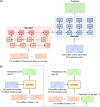Accurate surface ultraviolet radiation forecasting for clinical applications with deep neural network
- PMID: 33658568
- PMCID: PMC7930112
- DOI: 10.1038/s41598-021-84396-2
Accurate surface ultraviolet radiation forecasting for clinical applications with deep neural network
Abstract
Exposure to appropriate doses of UV radiation provides enormously health and medical treatment benefits including psoriasis. Typical hospital-based phototherapy cabinets contain a bunch of artificial lamps, either broad-band (main emission spectrum 280-360 nm, maximum 320 nm), or narrow-band UV B irradiation (main emission spectrum 310-315 nm, maximum 311 nm). For patients who cannot access phototherapy centers, sunbathing, or heliotherapy, can be a safe and effective treatment alternative. However, as sunlight contains the full range of UV radiation (290-400 nm), careful sunbathing supervised by photodermatologist based on accurate UV radiation forecast is vital to minimize potential adverse effects. Here, using 10-year UV radiation data collected at Nakhon Pathom, Thailand, we developed a deep learning model for UV radiation prediction which achieves around 10% error for 24-h forecast and 13-16% error for 7-day up to 4-week forecast. Our approach can be extended to UV data from different geographical regions as well as various biological action spectra. This will become one of the key tools for developing national heliotherapy protocol in Thailand. Our model has been made available at https://github.com/cmb-chula/SurfUVNet .
Conflict of interest statement
The authors declare no competing interests.
Figures





Similar articles
-
Space-based estimation of the solar UV-B doses for psoriasis heliotherapy in Poland using OMI data for the period 2005-2011.J Photochem Photobiol B. 2012 Dec 5;117:240-6. doi: 10.1016/j.jphotobiol.2012.10.007. Epub 2012 Oct 26. J Photochem Photobiol B. 2012. PMID: 23159506
-
Ultraviolet B radiation therapy for psoriasis: Pursuing the optimal regime.Clin Dermatol. 2016 Sep-Oct;34(5):587-93. doi: 10.1016/j.clindermatol.2016.05.008. Epub 2016 May 20. Clin Dermatol. 2016. PMID: 27638437 Review.
-
Perspectives of the antipsoriatic heliotherapy in Poland.J Photochem Photobiol B. 2014 Nov;140:111-9. doi: 10.1016/j.jphotobiol.2014.07.017. Epub 2014 Aug 1. J Photochem Photobiol B. 2014. PMID: 25116946
-
Comparison of the antipsoriatic efficacy of heliotherapy and ultraviolet B: a cross-over study.Photodermatol Photoimmunol Photomed. 1992 Apr;9(2):83-5. Photodermatol Photoimmunol Photomed. 1992. PMID: 1489722 Clinical Trial.
-
[New and established indications for phototherapy with narrowband UVB].J Dtsch Dermatol Ges. 2005 Nov;3(11):874-82. doi: 10.1111/j.1610-0387.2005.05072.x. J Dtsch Dermatol Ges. 2005. PMID: 16232274 Review. German.
Cited by
-
Variations in vitamin D status among Chinese children aged 1-6 years during the COVID-19 pandemic.Front Public Health. 2025 Jan 23;13:1514355. doi: 10.3389/fpubh.2025.1514355. eCollection 2025. Front Public Health. 2025. PMID: 39916704 Free PMC article.
References
-
- Menter A, Korman NJ, Elmets CA, et al. Guidelines of care for the management of psoriasis and psoriatic arthritis: section 5. Guidelines of care for the treatment of psoriasis with phototherapy and photochemotherapy. J. Am. Acad. Dermatol. 2010;62:114–135. doi: 10.1016/j.jaad.2009.08.026. - DOI - PubMed
-
- Patrizi A, Raone B, Ravaioli GM. Safety and efficacy of phototherapy in the management of eczema. In: Ahmad SI, editor. Ultraviolet Light in Human Health, Diseases and Environment. Advances in Experimental Medicine and Biology. Berlin: Springer; 2017. pp. 319–331. - PubMed
Publication types
MeSH terms
LinkOut - more resources
Full Text Sources
Other Literature Sources
Medical

